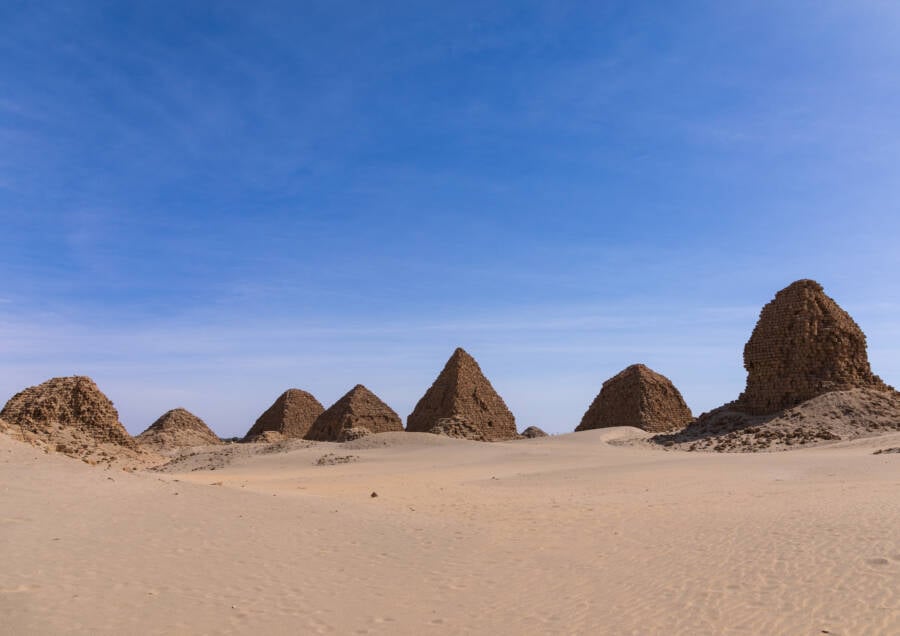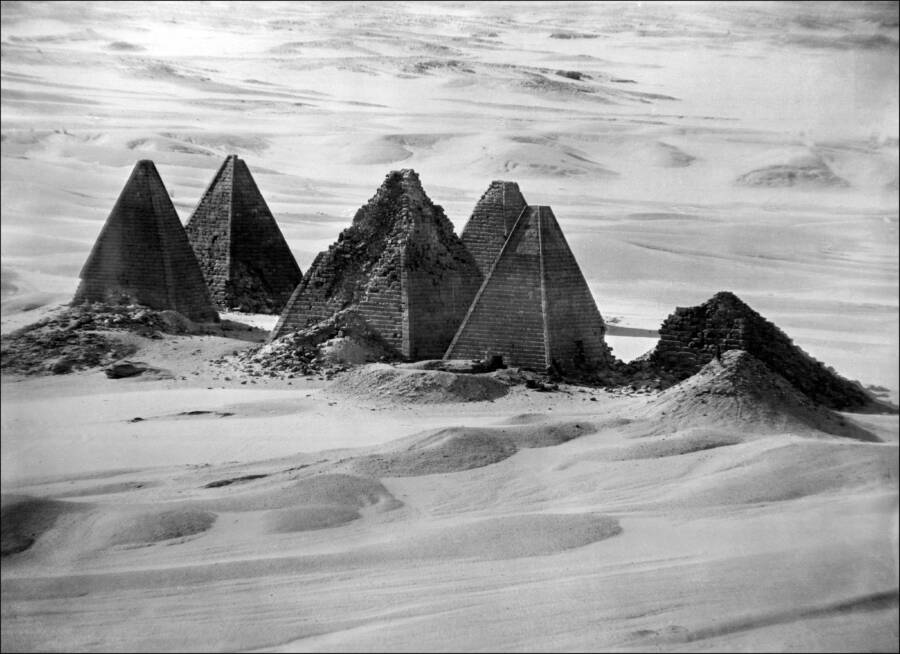The Nubian Pyramids Of Sudan Are Just As Impressive As Those In Egypt — So Why Aren’t They As Well-Known?
More than 250 pyramids that once held the remains of the "Black Pharaohs" of Kush dot the deserts of Sudan, but due to their remote location and the civil war that plagued the country for decades, they don't see nearly as many tourists as their Egyptian counterparts.
The word “pyramid” typically brings to mind the towering structures of Giza. However, the country with the largest number of pyramids is not actually Egypt. The Nubian pyramids of the ancient Kingdom of Kush put Sudan at the top of that list.
1 of 26
The Meroë pyramids at sunrise. 2016. Valerian Guillot/Flickr
2 of 26
A man rides a camel in front of the pyramids at Meroë. 2009. Retlaw Snellac/Flickr
3 of 26
A grouping of pyramids in Meroë as viewed from a side angle in 2017. Hans Birger Nilsen/Flickr
4 of 26
A local guide balancing on his camel in front of the Meroë pyramids in 2016. Nina R/Flickr
5 of 26
The Northern Cemetery at Meroë. 2017. Ron Van Oers/UNESCO
6 of 26
An alternate angle of the Northern Cemetery at Meroë in 2016. Nina R/Flickr
7 of 26
An 1821 lithograph of the Northern Cemetery at Meroë viewed from the northwest. Fréderic Cailliaud/Biodiversity Heritage Library
8 of 26
An 1821 engraving of the Northern Cemetery from the southeast. Fréderic Cailliaud/Biodiversity Heritage Library
9 of 26
The Southern Cemetery at Meroë. 2010. TrackHD/Wikimedia Commons
10 of 26
An 1821 engraving of the Northern and Southern Cemeteries at Meroë. Fréderic Cailliaud/Biodiversity Heritage Library
11 of 26
The Western Cemetery at Meroë. 2010. TrackHD/Wikimedia Commons
12 of 26
The Grand Pyramid of Amanishakheto in 1821 before it was destroyed by treasure hunters. Fréderic Cailliaud/Biodiversity Heritage Library
13 of 26
Aminashakheto's pyramid in Meroë in 2010, after its 1831 destruction by treasure hunters. TrackHD/Wikimedia Commons
14 of 26
A depiction of the Nubian ruler Amanitenmemide on the wall of his pyramid at Meroë. 2005. Julia Scherkunowa/Berlin Ägyptisches Museum
15 of 26
The Royal Nubian Cemetery at Nuri. 2017. Hans Birger Nilsen/Wikimedia Commons
16 of 26
An 1821 depiction of the pyramids at Nuri. Fréderic Cailliaud/Biodiversity Heritage Library
17 of 26
Jewelry found at the tomb of the Napatan king Amaninatekelebte underneath Pyramid 10 in Nuri. Hans Ollermann/Museum of Fine Arts Boston
18 of 26
A diadem found in the tomb of Talakhamani, who ruled over Meroë, under Pyramid 16 in Nuri. Hans Ollermann/Museum of Fine Arts Boston
19 of 26
An 1821 depiction of the pyramids at Jebel Barkal. Fréderic Cailliaud/Biodiversity Heritage Library
20 of 26
The main pyramid at El-Kurru, Sudan. Bertramz/Wikimedia Commons
21 of 26
A 2016 excavation of the main pyramid at El-Kurru. Valerian Guillot/Flickr
22 of 26
The pyramids at Jebel Barkal, Sudan alongside the Jebel Barkal massif. 2017.Hans Birger Nilsen/Wikimedia Commons
23 of 26
A depiction of the Jebel Barkal pyramids in 1821. Fréderic Cailliaud/Biodiversity Heritage Library
24 of 26
The pyramids at Jebel Barkal, as seen from the Jebel Barkal massif. Laurent de Walick/Wikimedia Commons
25 of 26
A man sitting on the Jebel Barkal massif overlooking the pyramids. Anmede/Flickr
26 of 26

The Nubian Pyramids Of Sudan Are Just As Impressive As Those In Egypt — So Why Aren’t They As Well-Known?
View Gallery
Overall, more than 250 pyramids were built across Nubia, which corresponds to the area between Aswan in southern Egypt and Khartoum in Sudan. The "Black Pharaohs" of Kush had them built as tombs between 700 B.C.E. and 300 C.E. So why aren't they as well-known as their Egyptian counterparts?
Many of the Nubian pyramids are located in remote areas of the Sudanese desert, far from hotels, restaurants, and other modern facilities. This limits the number of visitors who make the trek to see them. Meanwhile, the pyramids of Giza are located just outside Egypt's bustling capital city, attracting millions of tourists each year. In addition, the civil wars that have plagued Sudan in recent years have kept many travelers away.
Yet, despite their obscurity, these impressive structures of Sudan stand as a reminder of just how powerful ancient Kush truly was. Above, look through 25 photos of the stunning Nubian pyramids.
A Brief History Of The Nubian Pyramids
Around 750 B.C.E., after the fall of the 24th Egyptian dynasty, the Kingdom of Kush took over the region, according to Al Jazeera. The Nubian king Alara ruled from the city of Napata along the Nile River in what is today Sudan.
Given the vast Egyptian influence over the Nubian kings, the rulers began to use pyramids as burial sites. The first one was built around 700 B.C.E. in El-Kurru as the tomb of Alara's successor, Kashta, and his son, Piye.
As the Nubian dynasty grew in power and prestige, the El-Kurru site became too small to accommodate more pyramids. As a result, the Nubian kings built a new royal necropolis at Nuri, near their capital at Napata.

Eric Lafforgue/Art in All of Us/Corbis via Getty ImagesA group of royal pyramids in Nuri. 2018.
Then, around 590 B.C.E., the Nubian royal capital moved to Meroë, which sat near both a major iron smelting site and several primary trade routes. Kings continued building their pyramids, and Meroë soon grew to be the largest necropolis in Nubia.
By 330 C.E., the Kingdom of Aksum, located in modern-day Ethiopia, had invaded Meroë. That marked the end of the mighty Kingdom of Kush — and the end of the Nubian pyramids' construction.
Excavating The Ancient Pyramids Of Nubia
Academic exploration of the Nubian pyramids began in earnest in the 1800s. Before then, the structures had been at the mercy of graverobbers, who took any valuables they could get their hands on. They even made off with the remains of the royalty inside.
In the 1830s, according to Amusing Planet, an Italian explorer named Giuseppe Ferlini smashed the tops off of 40 of the pyramids in an effort to find treasures hidden inside.
By the time archaeologists from around the world began studying the pyramids, there wasn't a lot left to see. However, they did discover that the Nubian pyramids differed from their Egyptian counterparts in two major aspects.

History/Universal Images Group via Getty ImagesNubian pyramids in Meroë in 1906.
First, the pyramids had a much smaller base and steeper sides. While the Great Pyramid of Giza stands more than 450 feet tall, the pyramids of Nubia range in height from 20 to 100 feet.
Second, the burial chambers of the Nubian pyramids were generally located beneath the pyramids instead of within them. In Egypt, tunnels and stairs typically led to the rooms where royal sarcophagi were kept. In Kush, the entrances to the burial chambers were hidden outside of the pyramids, and steep steps led down to the underground tombs. The pyramids themselves were simply filled with dirt and rubble.
Per Google Arts & Culture, archaeologists did find artifacts like horse harnesses, pottery, and goods from far-reaching places such as Rome, India, and China that provided valuable insight into ancient global trade routes. They also discovered canopic jars inside some of the burial chambers, suggesting that the kings of Kush were mummified in the same way as the pharaohs of Egypt.
But though they're just as visually impressive as the pyramids of Egypt and have an equally stunning history, the Nubian pyramids still don't receive nearly as much tourism or funding — and unfortunately, that may not change any time soon.
The Modern-Day Challenges Facing The Nubian Pyramids
Even after surviving centuries of local graverobbers and shameless European explorers, the Nubian pyramids still face threats from multiple sides today.
First, the impacts of climate change in the region have made sandstorms more frequent and more intense. The pyramids sit atop dunes, so the shifting sands beneath the structures threaten to damage them irreparably.
Additionally, heavy rains in 2020 led to fears that the Blue Nile River would overflow its banks and wash away the historic sites. UNESCO even expressed "its deep concern" about the flooding and its effects on the pyramids.
Then there is the lack of tourism to the sites. From 1955 to 1972 and again from 1983 to 2005 and from 2013 to 2020, civil war gripped Sudan. Many countries warned their residents against visiting the area, and even today the U.S. Department of State places Sudan under the highest-level travel advisory: "Do Not Travel."

Twitter/Al JazeeraA small Nubian pyramid that has been restored to its former shape.
Without tourism and funding, it is difficult for the Sudanese government to maintain the pyramids. A few of the smaller ones have been restored, but many have simply become crumbling piles of sandstone.
Regardless of the threats facing the pyramids, however, locals have vowed to defend them.
As a Sudanese man named Aya Allam told National Geographic: "These were very popular kings and queens. They are a reminder that we were once a great nation and could become great once again."
After looking through these photos of the Nubian pyramids, read about other pyramids located outside of Egypt. Then, go inside the discovery of an ancient cathedral from the Kingdom of Makuria, which followed the Kingdom of Kush.
Related Posts
By accepting you will be accessing a service provided by a third-party external to https://oc3anclub.com/

